Posted by Anita on 04.29.10 12:52 PM
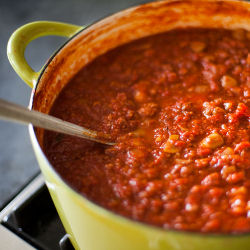 Michael Ruhlman ruffled a lot feathers when he called bullshit on people who can’t find time to cook. To be sure, there are people out there making poor choices, watching hours of TV yet kvetching they can’t put any energy into feeding themselves or their families. But leaving this (admittedly large) group aside for a moment, I also know there are many smart, thoughtful people who simply can’t spend even an hour every day in the kitchen.
Michael Ruhlman ruffled a lot feathers when he called bullshit on people who can’t find time to cook. To be sure, there are people out there making poor choices, watching hours of TV yet kvetching they can’t put any energy into feeding themselves or their families. But leaving this (admittedly large) group aside for a moment, I also know there are many smart, thoughtful people who simply can’t spend even an hour every day in the kitchen.
Take our household, as one example. I honestly don’t think anyone could question our devotion to good food and home cooking. We go to the farmers market every damned week, even when it’s pouring buckets. We grow a lot of our own produce, though it would be far simpler to buy it. And we preserve both our own harvest and foods we buy in season. We cure our own meats, from time to time. We spend whole days — whole weekends, even — focused on putting real food on our table, and sharing it with people we care about.
But even though I love nothing more than spending hours in the kitchen, the realities of my job and my life mean it’s a luxury that I can’t have all the time.
I know Ruhlman loves to stir the pot — and god love him for that, the world needs more agitators. I also know that his reality is different from mine, and probably yours: This is a man who works at home and devotes his professional life to food. His bread-baking is integrated into his bread-winning in a way that few of us could manage. But for many people, even his simple roast chicken is too much work. Hell, on some particularly craptacular nights, roast chicken is too much work for me. I’m not proud of that. But on the other hand, I don’t beat myself up about it. As Cameron often says: “We eat better at home than most people do in restaurants.” And I think that’s true even when we’re defrosting, reheating, and MacGyvering our way to the table.
We (by which I mean all of us who care about food, and health, and community) need to teach people to make good food in whatever time they have available, not heap scorn on those who think that 30-Minute Meals are the answer. I can make dinner — organic, local, balanced food — in 15 minutes if pressed. It may not be pretty, but it’s real and it’s delicious.
I’ve been cooking since I was old enough to reach the countertop, though, and a lot of what allows me to make those on-the-fly meals happen is the result of hard work at some point days or weeks earlier. Cooking on a daily basis requires planning. It also means relying not necessarily on convenience foods, but convenient food. It’s equal parts planning ahead, stocking your larder, and knowing your limitations — things that can take years to master by trial and error. We shouldn’t expect people to come straight to the kitchen knowing what they need to do.
I realize, as I write all this, that in a way I’ve been part of the problem.
I rarely mention, much less post, our quick-and-dirty weeknight meals. They’re often less-than-photogenic specimens, and they’re usually the sort of food you don’t really need a recipe to make. When I do resort to posting something unglamorous, it’s usually because I’ve signed on for a challenge, and the deadline is looming. I always feel odd, writing about a dinner that isn’t picture perfect, because it feels like I am shortchanging my readers. But on the other hand, I think (hope!) you all realize that we don’t eat beautiful food seven days a week.
 So here’s my commitment: Every week, for the next 12 weeks, I’m going to write about a trick I use to get dinner on the table quickly. I’ll also give you a little homework: Something simple enough that you can do it while your partner washes up after dinner, or in an hour or so on the weekend. And each post will include a recipe to show how to use the week’s tip in a real-life setting, usually a tried-and-true supper we actually eat on a regular basis. I’ll answer questions in the comments, and hopefully we can all learn from one another.
So here’s my commitment: Every week, for the next 12 weeks, I’m going to write about a trick I use to get dinner on the table quickly. I’ll also give you a little homework: Something simple enough that you can do it while your partner washes up after dinner, or in an hour or so on the weekend. And each post will include a recipe to show how to use the week’s tip in a real-life setting, usually a tried-and-true supper we actually eat on a regular basis. I’ll answer questions in the comments, and hopefully we can all learn from one another.
When I get to the bottom of my bag of tricks, I’ll throw it open to you. We’ll have a roundup event, where you can either use my tips to create your own weeknight meal, or post a time-saver of your own. By August, you’ll know what I know, and you’ll have put it into practice so you can riff on it yourself.
I may be preaching to the choir here; if you’re reading this blog, you may be doing these things already. On the other hand, a quick straw poll of my food-loving pals tells me there’s value in this exercise, even for the veterans. But fear not: I’ll keep things simple enough that novice cooks will be able to put the tips to use, too.
So, who’s with me: Who wants to play along?
cooking, Dinner on a Deadline
79 Comments »




Posted by Anita on 04.24.10 9:06 PM
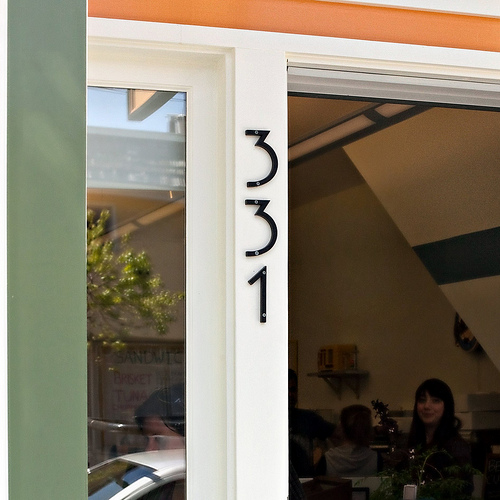 The newest addition to the ever-growing list of Bernal Heights culinary resources can be found at 331 Cortland, both the name and the address of a conglomeration of food-centric stalls in a single storefront. After longer-than-expected delays for construction and permitting — apparently, nobody in city hall knew quite how to handle a multi-unit setup under one roof — the six marketplace vendors held a soft opening today for their Bernal neighbors.
The newest addition to the ever-growing list of Bernal Heights culinary resources can be found at 331 Cortland, both the name and the address of a conglomeration of food-centric stalls in a single storefront. After longer-than-expected delays for construction and permitting — apparently, nobody in city hall knew quite how to handle a multi-unit setup under one roof — the six marketplace vendors held a soft opening today for their Bernal neighbors.
We stopped in around 3pm and found a good-sized crowd full of happy folks getting their afternoon snack on. Bernal Cutlery features Japanese whetstone knife sharpening, plus a beautiful assortment of knives both culinary and otherwise. El Porteño, a familiar vendor at many local farmers markets, carries their full line of sweet and savory Argentinian empanadas. Paulie’s Pickling sells pickles, of course, as well as a rotating selection of sandwiches and deli salads.
On the other side of the shop, Wholesome Bakery features vegan and low-glycemic treats and breads. ICHI Lucky Cat Deli, the new home of ICHI’s itinerant sushi-makers, offers nigiri, maki, and sashimi, as well as some specialty snacks (katsu-sando sliders, oh my!). In the front window, Della Terra Organics sells a pretty assortment of fresh produce from local farms. Each of the vendors will set their own hours, but the marketplace as a whole plans to be open 7am to 7pm every day.
It’s a plethora of options, and a welcome addition to the area. The new marketplace joins the small but quite comprehensive Good Life Grocery, the much-lauded Avedano’s Meats down the block, and newcomer Sandbox Bakery at the other end of the Cortland shopping district. You can stroll a few blocks and pick up pretty much everything you need for a picnic in Holly Park, or a home-made dinner. Surprising as it seems, once-sleepy Bernal could actually become food-lover’s shopping destination.
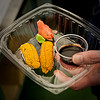
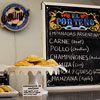

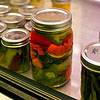
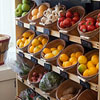
The Marketplace at 331 Cortland
331 Cortland Avenue (x Bennington)
San Francisco, CA 94110
@331Cortland on Twitter
ICHI Lucky Cat Deli
http://ichisushi.com
415-822-4024
@ICHIsushi on Twitter
El Porteño Empanadas
http://www.elportenosf.com
415-357-3621
@ElPorteno on Twitter
Paulie’s Pickling
http://www.pauliespickling.com
415-285-0800
@PauliesPickling on Twitter
Wholesome Bakery
http://www.wholesomebakery.com
415-343-5414
@wholesomebakery on Twitter
Bernal Cutlery
http://www.bernalcutlery.com
415-902-6531
@BernalCutlery on Twitter
Della Terra Organics
http://www.dtoproduce.com
Bernal, locavore, shopping
2 Comments »




Posted by Anita on 04.23.10 4:53 PM
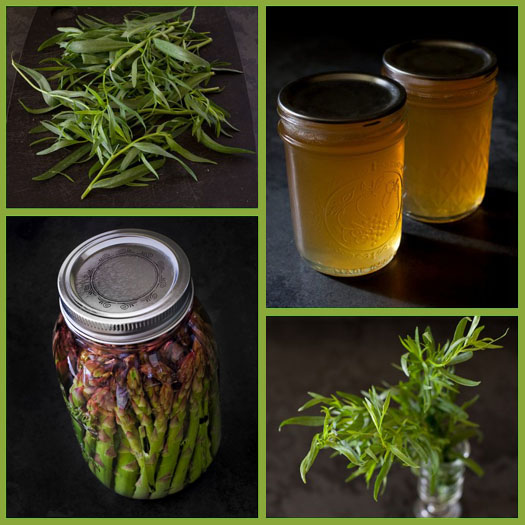
This month’s CanJam roundup — hosted by Marisa at Food in Jars — focuses on herbs, a fitting subject for a month when many canners have little fresh produce close at hand. Our garden is overflowing with herbs, but in the spirit of exploration I decided to make use of a big bunch of tarragon from our latest Mariquita Farm delivery. My only problem was deciding whether to make a sweet preserve or a savory pickle.
Eventually I rationalized that there will be plenty of time later in the year to put up fruit, and pondered the early spring crops I know I would be craving later. Top of that list is asparagus, so I started by using my herbal ingredient to flavor a batch of asparagus pickles. After all, béarnaise sauce — essentially a Hollandaise flavored with tarragon and shallots — and asparagus are natural partners.
Aside from the fiddly task of trimming each spear to the height of a quart jar, the pickled asparagus was simple enough. but I found myself with plenty of leftover tarragon. Rather than wait another week for the next farmers market to put up more asparagus, I rummaged around to see what else I had on hand that would pair well with this anise-scented herb. A quick turn through my canning books yielded a simple recipe for fresh herb jelly, using a base of dry white wine.
I didn’t want to crack a full bottle of vino to get the cup and a half I needed for the recipe, but I did have a half-bottle of bubbly leftover from a recent brunch; swapping in Champagne vinegar for the recipe’s white wine vinegar made the Champagne theme complete. The resulting preserve isn’t the sort of thing you’d spread on toast, or swirl into yogurt — at least to my palate. Much like other savory-sweet jellies (like popular ones that feature jalapeno or mint) this jelly works well as a companion to cheese and crackers, or as a condiment for roast meats.
Asparagus Pickles with Tarragon
– adapted from Jan Roberts-Dominguez, Eugene Register-Guard
2-3/4 cups white distilled vinegar
2-1/4 cups water
3T canning salt
2 sprigs tarragon, about 4 inches long
3 bunches tender asparagus, preferably thin stalks, washed
2 small shallots, peeled and partially split in half
2 garlic cloves, peeled and partially split in half
2 tsp mustard seed
2 tsp whole peppercorns
Prepare canner, lids, and two narrow-mouth 1-quart jars according to the usual method; keep jars hot until needed. 
In a medium saucepan, combine the vinegar, water, and salt over high heat.
Meanwhile, trim the asparagus of any white or tough ends, then cut to the height of the jars’ shoulders. (There are usually enough tender trimmings to make asparagus pesto.)
Divide the tarragon among the two jars, then pack the trimmed asparagus into the jars, along with 1 shallot and 1 clove of garlic per jar. Sprinkle in the mustard seed and peppercorns, then pour in the boiling brine, leaving 1/2-inch headspace. Wipe rims and center lids on jars. Screw band to fingertip-tight.
Place jars in canner, ensuring they are completely submerged. Bring to a boil and process covered for 10 minutes. Remove canner lid; wait 5 minutes, then remove jars. Cool, check for seals, and store in a cool, dark place for up to a year.
(For crisper spears, you can also make these as refrigerator pickles: Seal the jars after pouring in the brine, but do not process. Cool completely to room temperature, then store in the refrigerator for up to 3 months.)
—
Champagne Tarragon Jelly
– adapted from the Ball Complete Book of Home Preserving
2 cups loosely packed, coarsely chopped tarragon
1-1/2 cups sparkling wine
1 cup water
1 cup Champagne vinegar
1 packet powdered fruit pectin (1-3/4oz) *
5 cups granulated sugar
Prepare canner, lids, and five 8-oz jars according to the usual method; keep jars hot until needed.
Combine tarragon, sparkling wine, water, and vinegar in a large stainless steel saucepan. Bring to a boil over medium heat, then remove from heat and cover, steeping for 15 minutes. Stir well, pressing tarragon to extract flavor.
Pour the tarragon mixture through a dampened jelly bag (or a strainer lined with several layers of dampened cheesecloth) set over a deep bowl. Let drip, undisturbed and without squeezing, until all of the liquid has fallen from the tarragon. (At this point, you should have 3-1/4 cups liquid.)
Transfer the liquid to a clean deep stainless steel saucepan. Whisk in the pectin* until completely dissolved, then bring to a boil over high heat, stirring frequently. Add sugar all at once and return to a full rolling boil, stirring constantly. Boil hard, stirring, for 1 minute. Remove from pan from the heat and quickly skim off any foam as needed.
Using a stainless-steel canning funnel, pour hot jelly into hot jars, leaving 1/4-inch headspace. Wipe rims and center lids on jars. Screw band to fingertip-tight.
Place jars in canner, ensuring they are completely submerged. Bring to a boil and process covered for 10 minutes. Remove canner lid; wait 5 minutes, then remove jars. Cool, check for seals, and store in a cool, dark place for up to a year.
—
* If using Pomona’s Natural Pectin, use 3T pectin powder, and combine it with 1 cup of the sugar before proceeding.
CanJam, preserving & infusing, recipes
9 Comments »




Posted by Anita on 04.18.10 12:03 PM
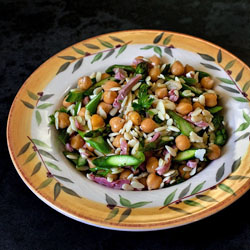 Now that the Dark Days are over, we’re back in the kitchen, casting hungry eyes on spring’s new crops. We’ve had asparagus at our markets now for more than a month, and we’re gorging ourselves on it every week. It’s making its way into every course but dessert!
Now that the Dark Days are over, we’re back in the kitchen, casting hungry eyes on spring’s new crops. We’ve had asparagus at our markets now for more than a month, and we’re gorging ourselves on it every week. It’s making its way into every course but dessert!
For a recent brunch party with friends, I wanted to include asparagus on the menu — it’s such a perfect spring flavor — but didn’t really want to mess around with Hollandaise sauce, or any of the other prepped-to-order asparagus dishes in my repertoire. None of the recipes for asparagus salads I found really appealed to me, so I winged it, adding ingredients until I found a combination that looked as good as it tasted.
The recipe below was more than enough as a side dish for 8. Our guests took home some of the leftovers, and we still had enough for two lunch-size portions. So unless you’ve got a big group on hand, or you’re serving it as a main course, a half batch should be more than sufficient.
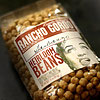

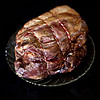
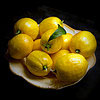
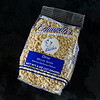
Asparagus Salad
– serves 8 as a light meal, or 16 as a side dish
1 bunch medium asparagus
8oz orzo
1-1/2 cup matchstick-sized pieces of ham
2/3 cup extra-virgin olive oil
1 tsp finely grated fresh lemon zest
1/4 to 1/3 cup fresh lemon juice
1 tsp salt
1/2 tsp black pepper
3 cups cooked garbanzo beans, rinsed and drained
Parmesan cheese, broadly shaved with a peeler (1/2 cup)
1/3 cup chopped fresh flat-leaf parsley
Cut asparagus on the bias into 1/8-inch slices, discarding woody or tough ends. Cook the orzo al dente, then rinse in cool water to cool; drain well, shaking the colander to remove excess water.
In a wide skillet, bring oil, zest, juice, salt, and pepper to a simmer. Stir in the garbanzo beans, then remove from heat and let steep. When beans have cooled to near room temperature, place in a large bowl along with their dressing. Toss with the orzo, ham, Parmesan cheese, and parsley. Taste and adjust seasonings as needed. Serve at room temperature, or cold.
Note: As long as your ingredients are fresh and the pasta very well drained, the salad can be prepared up to 8 hours ahead with no loss of texture.
entertaining, recipes
3 Comments »




Posted by Anita on 04.04.10 9:43 AM
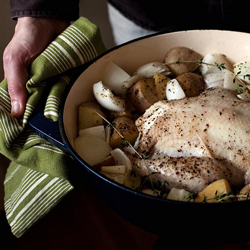 Spring has come to the blog: We made it to the end of the Dark Days Challenge! We’re excited to share some spring recipes with you soon. But before we head off into the sunshine, I’m sending a round of applause to all the other Dark Days bloggers who stuck it out to the end, especially our hostess, Laura at (not so) Urban Hennery.
Spring has come to the blog: We made it to the end of the Dark Days Challenge! We’re excited to share some spring recipes with you soon. But before we head off into the sunshine, I’m sending a round of applause to all the other Dark Days bloggers who stuck it out to the end, especially our hostess, Laura at (not so) Urban Hennery.
It’s been funny, pretending it was still Dark Days when the weather — and the market — make it clear that spring is upon us. Despite last week’s avocado orgy, we’ve tried to stick with the spirit of the challenge (and not torture participants in colder climates), using pantry goods and foraging in the freezer.
The weather has been obligingly wintery here in San Francisco this past week, so for our final Dark Days meal, we turned to a cool-weather dish I’ve been wanting to try for months. I came across this recipe in the River Cottage Cookbook, and was captivated: Why on earth had I never heard of pot-roast chicken before? We make pot roast with beef, and pork, and even lamb, but apparently the Brits (or at least Hugh F-W) know something we don’t. Dead simple, this one: Just chunk up whatever hardy vegetables you have on hand — vary the list below with the seasons, so long as there’s a starch and some onions — pop them in a big pot with a chicken in the middle, and Bob’s your uncle.
We made a few tweaks to the River Cottage recipe: Even once it was fully cooked, we found the chicken a little flabby and the pan juices a little thin for our taste. We solved both problems by popping the chicken back in the oven on its own for a few minutes to crisp the skin while reducing the pan juices a bit on the stove top. (Even if you don’t take this extra step, everything tastes delicious.) Cooked in this novel method, even the breast meat stays moist — a perfect ingredient for, say, chicken salad the next day. And should you have any leftover vegetables, they make a fine soup pureed with chicken stock and garnished with a bit of cream and a sprig of herbs.
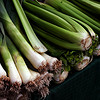


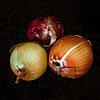

Pot-Roast Chicken and Vegetables
– adapted from The River Cottage Cookbook
1 chicken, 4 to 6 pounds
2T butter
2 tsp salt
freshly ground black pepper
2 onions
3 large carrots
3 stalks of celery
2 leeks
3 potatoes
2 bay leaves
1 cup white wine
1 cup unsalted chicken stock (or water)
3 sprigs of thyme
Preheat the oven to 375°F. Cut up the vegetables into large chunks. Smear butter over the top of the chicken, and season with salt and pepper. Place the buttered chicken in a large casserole or a deep lidded roasting pan, and surround with the chunked vegetables. Pour in the wine and stock, add the thyme, cover, and place in the preheated oven.
After an hour, remove the lid; stir the vegetables and baste the chicken with the fat on the top of the pan juices. Return to the oven, uncovered, for another 30 minutes or until the breast is browned and the juices run clear at the thigh.
Carve the chicken into individual portions and place in an oven-safe plate or pan; return it to the oven to get a little more brown and crispy while you finish the pan juices. Remove the vegetables to a serving bowl, and cover to keep warm. On the stove, simmer the juices in the roasting pan, reducing to a medium consistency (or as you like).
Farmers and food artisans who created the ingredients for this week’s meal:
Soul Food Farm, Vacaville: chicken
Catalán Family Farm, Hollister: onion, leeks, celery
Dirty Girl Produce, Santa Cruz: carrots
Little Organic Farm, Marin: potatoes
Spring Hill Cheese Company, Petaluma: Jersey butter
Souverain, Geyserville: white wine
Guisto’s Vita-Grain, South San Francisco: sea salt
…and our own homegrown bay leaves and thyme, and home-canned chicken stock
exemptions: black pepper
Dark Days challenge, locavore, meat, recipes
Comments Off on Dark Days, spring chicken




 Michael Ruhlman ruffled a lot feathers when he called bullshit on people who can’t find time to cook. To be sure, there are people out there making poor choices, watching hours of TV yet kvetching they can’t put any energy into feeding themselves or their families. But leaving this (admittedly large) group aside for a moment, I also know there are many smart, thoughtful people who simply can’t spend even an hour every day in the kitchen.
Michael Ruhlman ruffled a lot feathers when he called bullshit on people who can’t find time to cook. To be sure, there are people out there making poor choices, watching hours of TV yet kvetching they can’t put any energy into feeding themselves or their families. But leaving this (admittedly large) group aside for a moment, I also know there are many smart, thoughtful people who simply can’t spend even an hour every day in the kitchen. So here’s my commitment: Every week, for the next 12 weeks, I’m going to write about a trick I use to get dinner on the table quickly. I’ll also give you a little homework: Something simple enough that you can do it while your partner washes up after dinner, or in an hour or so on the weekend. And each post will include a recipe to show how to use the week’s tip in a real-life setting, usually a tried-and-true supper we actually eat on a regular basis. I’ll answer questions in the comments, and hopefully we can all learn from one another.
So here’s my commitment: Every week, for the next 12 weeks, I’m going to write about a trick I use to get dinner on the table quickly. I’ll also give you a little homework: Something simple enough that you can do it while your partner washes up after dinner, or in an hour or so on the weekend. And each post will include a recipe to show how to use the week’s tip in a real-life setting, usually a tried-and-true supper we actually eat on a regular basis. I’ll answer questions in the comments, and hopefully we can all learn from one another.























